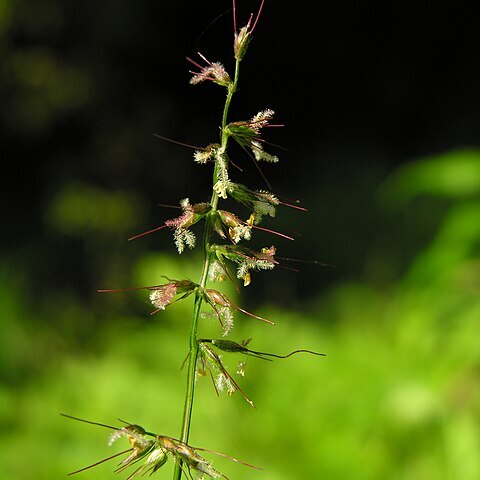Perennials or annuals. Culms trailing, ascending from a decumbent base, the internodes mostly with a villous line adaxial to the subtending leaf. Leaf blades ovate, lanceolate or linear-lanceolate, often with cross veins; ligule a ciliate membrane. Inflorescence composed of several unilateral racemes spaced along a central axis; racemes elongate or reduced to fascicles of a few spikelets, spikelets usually paired on short pedicels, the lowermost often reduced. Spikelets lanceolate to oblong, weakly dorsally or laterally compressed, florets 2; glumes subequal, 1/2–3/4 spikelet length, often pilose, the lower or both tipped by a viscid awn; lower lemma equaling the spikelet, acute to shortly awned, its palea absent or much reduced; upper lemma papery or subcoriaceous, smooth and shiny, acute, indistinctly crested. x = 9.
Spikelets subsessile, solitary or in pairs, crowded, in two rows on one side of a slender rachis; glumes nearly equal, more than half as long as the sterile lemma, 3-to 5-nerved, the first long-awned, the second short-awned; sterile lemma longer than the fruit, mucronate or short-awned, enclosing a hyaline palea; fruit elliptic, acute, indurate, smooth and shining, the margins firm, enclosing the palea. Creeping, branching annuals or perennials with thin lanceolate or lanceolate-acuminate blades and inflorescences composed of few to several short, stiffly ascend-ing or spreading racemes approximate or rather distant on a main axis.
Inflorescence of short racemes along a central axis, the spikelets in pairs (but the inferior often reduced).
Superior lemma dorsally compressed, coriaceous with involute margins.
Glumes 1/2–3/4 length of spikelet, the inferior of both awned.
Spikelets laterally compressed, lanceolate.


